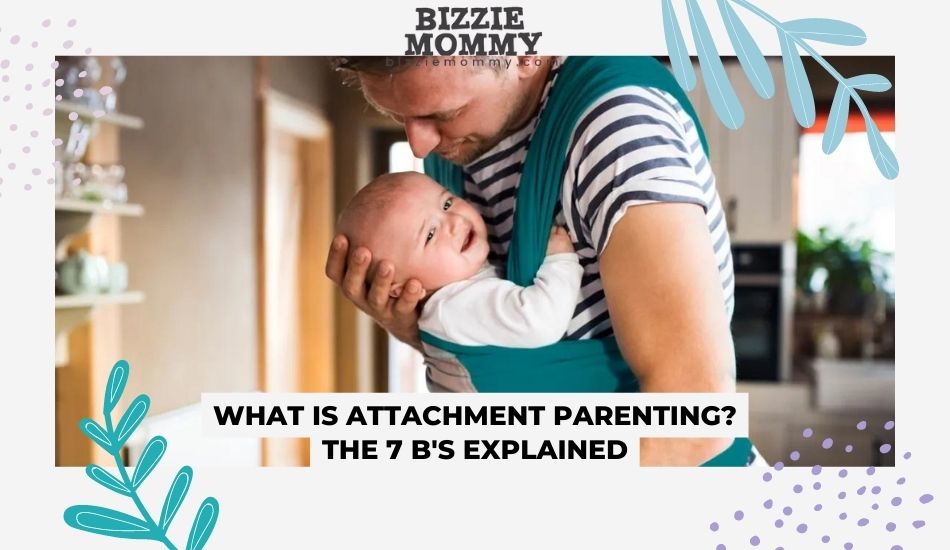Attachment parenting, also known as responsive parenting, is a parenting style that explains that babies have a positive development when they are given attention from their parents. Parenting styles are confusing for many people, and many parents constantly ask,’ What is attachment parenting?’ That will be answered here. Not just the basic principles, but we will also go a little deeper into other parenting styles too.
The attachment parenting book has 7 B’s, which have seven different principles such as breastfeeding, bed-sharing, etc. Attachment parenting and gentle parenting style are kind of the same and produce the same results in little children. While attachment parenting is a more positive parenting approach, the most disruptive one would be disorganized attachment parenting, which will also be discussed here.
Explain the Attachment Parenting Theory
The term attachment parenting is a modern parenting philosophy that revolves around the idea that babies can develop a strong sense of trust when their needs are adequately met by a caregiver early in life. According to proponents of attachment theory, kids who don’t develop secure attachments during childhood have a harder time creating secure relationships as adults, which can result in anxiety, low empathy, and sometimes even attachment problems.
The attachment parenting theory is a contemporary approach to parenting that draws its inspiration from the attachment theory. Attachment parenting focuses on the belief that the relationship between a parent and their baby and the parent’s responsiveness to the baby’s needs can have a deep and lasting effect on the baby’s emotional well-being and future relationships.
The attachment parenting style extends this idea by placing emphasis on developing strong physical and emotional bonds between parents and their infants through specific techniques. These techniques are designed to foster maximum empathy, responsiveness, and physical touch between parent and baby.
Basic Principles of Attachment Parenting
API (Attachment Parenting International) is a globally recognized organization that promotes and educates the world on the basic principles of attachment parenting. Attachment Parenting International outlines eight essential elements of this approach to parenting.
The very first principle is preparation for pregnancy, birth, and parenting by eradicating any bias and unhappiness about parenthood or pregnancy. This helps parents emotionally with the difficulties of parenthood.
The next principle is to nourish the infant with affection and respect, with breastfeeding being the preferred method for developing a close bond with the child. Additionally, it focuses on teaching small kids that their parents will attend to their requirements and respond to their cues.
The third principle is to react delicately, viewing every child’s emotional display, even tantrums, as an effort at communicating that must be respected and appreciated.
The fourth principle of attachment theory is to use nurturing touch, promoting skin-to-skin contact through joint baths and baby-wearing.
The fifth principle is to engage in nighttime parenting by making co-sleeping arrangements and keeping the baby in the same room with the parents. However, you should note that the American Academy of Pediatrics has deemed bed-sharing unsafe, as it can cause a rise in the risk of SIDS.
The sixth principle of attachment theory is to give consistent care and love, with a focus on the parent being present around the child as much as possible, and to not put a child under 30 months old in childcare for more than 19-20 hours per week.
The seventh principle is to practice positive discipline, using distraction, redirection, and guidance to model positive behavior and working with children to understand and resolve negative behavior.
The eighth principle is to always seek balance in both personal and family life, make connections, lead an active lifestyle, and prevent burnout.
What Are Attachment and Evolution
John Bowlby’s attachment theory in psychology is a groundbreaking contribution that stems from his work as a psychiatrist in the 1930s at a Child Guidance Clinic in London. Bowlby’s treatment of emotionally disturbed children exposed him to the significance of the mother-child relationship and its impact on a child’s social, emotional, and cognitive growth. This experience shaped Bowlby’s theory that early separation from the mother can lead to maladjustment in later life.
According to Bowlby (1958), attachment has historical roots, and the caregiver—typically the mother—plays a crucial part in ensuring the security and protection of the baby. As attachment behavior is naturally pre-programmed in infants, this increases the infant’s survival chances. When feeling disturbed or endangered, actions like wanting to be close to the caregiver are signs of attachment. In conclusion, Bowlby’s attachment theory highlights the importance of a secure and supportive relationship between a child and their caregiver for their overall development and well-being.
7 B’s of Attachment Parenting
Dr. Sears is known for popularizing the concept of attachment parenting, which he has distilled into seven principles known as the “7 Baby B’s” or “Attachment Tools.” These principles emphasize the importance of building a strong connection between parents and children.
- The first tool of attachment parenting, birth bonding, stresses the importance of immediate skin-to-skin contact and constant togetherness between parent and baby during the first six weeks after birth. This is seen as a crucial step in establishing a healthy and long-lasting parent-child attachment.
- Another crucial component of attachment parenting is breastfeeding, with a focus on the advantages it offers to both mother and child. According to research, nursing strengthens the mother-child relationship by raising levels of bonding chemicals like prolactin and oxytocin.
- In order to increase bonding, contact, and awareness of an infant’s needs, carrying a baby is also suggested. This can help parents respond more quickly and effectively to their baby’s cries and signals.
- Putting your bed close to the baby is another principle of attachment parenting, which adds to the importance of both baby and parent getting a good night’s sleep. Co-sleeping is thought to ease overnight nursing challenges and lessen feelings of separation anxiety.
- The belief in the language value of your baby’s cry is an important component of attachment parenting, with an emphasis on responding to a baby’s cries quickly and sensitively. This helps build trust and understanding between the baby and the caregiver.
- Sears also strongly discourages what he calls “convenience parenting,” which prioritizes a parent’s ease and comfort over the baby’s needs and emotional bonding. He suggests avoiding parent-scheduled feedings and other practices that detract from the development of a strong parent-child bond.
- Finally, balance is a crucial component of attachment parenting, with a focus on ensuring that parents maintain a healthy balance between parenting, their own personal needs, and their relationships. By adhering to these principles, parents can foster a strong and lasting attachment with their babies.
Define Secure Attachment, Anxious- Ambivalent Attachment

Secure Attachment
Secure attachment is considered one of the healthiest attachment parenting styles. This type of attachment results in a child feeling comforted and protected by their caregiver, who they trust and rely on. Securely attached children are also more confident in exploring their surroundings as they feel safe and secure with their caregivers nearby.
This type of attachment has long-lasting impacts on an individual’s development and is crucial for healthy growth. In adulthood, a kid with a parent who provides a stable attachment is more likely to have stronger self-esteem, the best overall relationships, and a better potential for trust.
Ambivalent Attachment
On the other hand, there is a type of insecure attachment called ambivalent attachment, also known as anxious preoccupied attachment. Children with this type of attachment are constantly attached to their caregiver but remain distressed even when their caregiver tries to comfort them. This can be difficult for the caregiver, as they are unable to soothe the child, leading to a negative cycle of interaction. Children with an ambivalent attachment may want to be close to their caregiver but lack the trust to rely on them for support.
As children with an ambivalent attachment parent grow up, this type of attachment often leads to clinginess and distrust in other relationships that they form in their lives. In conclusion, secure attachment is important for a child’s healthy development and has long-lasting impacts, while ambivalent attachment can lead to negative cycles and mistrust in relationships.
What Is Disorganized Attachment? Causes?
Disorganized attachment, also known as fearful-avoidant attachment, is a type of reactive attachment disorder where children have an unstable connection with their caregiver and experience fear towards them. This type of attachment is formed due to the inconsistent behavior of the primary caregiver, who is sometimes supportive and, at other times, emotionally damaging, making the child unsure of their ability to meet their needs. This is one of the attachment styles common in abusive homes, leading to insecure attachment from trauma in a child’s life. In adulthood, it can result in mental health problems, such as substance abuse and borderline personality disorder.
Causes
Home environment and parental involvement are constant factors in disorganized insecure attachment.
One of the most common reasons is having an abusive caretaker. This occurs when parents consistently fail to respond in an acceptable emotional way to their children’s suffering, or when they respond indifferently to their children’s feelings of dread or anxiety. Nearly 80% of infants in such households have insecure attachment problems.
A disorganized kid is afraid of the caregiver and their erratic abuse. But they also have to rely on that individual to survive. Emotional deprivation frequently happens when a child’s caretakers are both the source of their fear and the only known place where they can find shelter. These guardians are generally harsh and narrow-minded. The infant is unable to apply any planned coping mechanism when the caregiver’s terror is evident but unresolved. Another risk factor that may affect the child’s development of insecure attachments is a parent who is abusive to their partner.
Criticisms of Attachment Parenting
Critics of attachment parenting argue that excessive bonding with a baby can have negative consequences. This theory is controversial, as early research was based on animal studies. Some believe it should be updated to reflect the changing times and multiple caregivers that children are exposed to now.
Critics also claim that too much attention to a child’s needs can lead to over-dependency and stress for the parent. However, proponents of attachment parenting argue that secure attachments are necessary for a child’s well-being, and that a lack of attachment can lead to serious psychiatric issues. Despite the debate, most would agree that close emotional bonding with a baby is beneficial, but there may be a fine line between too much and just enough.
Bottom Line
Attachment Theory can help to form secure relationships between a child and his parents, especially a secure mother-child attachment. Constant physical closeness is a way to develop a baby’s secure attachment with its caretaker. Practicing attachment parenting is good for a child in the behavioral and developmental view as well as the emotional sensitivity of older children.

